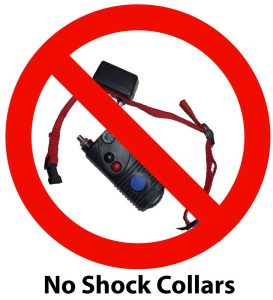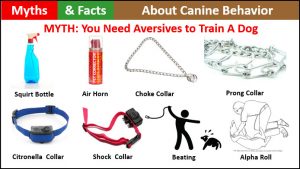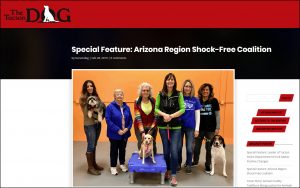< A version of this article was published in the February 2019 issue of Downeast Dog News >
< A short link to this article on my blog – < http://bit.ly/Things-Aversives-2 >
< A short link to all the articles in this series – http://bit.ly/ThingsIWishIHadKnown >
 Last month I described how in 1991 I had been told to use a choke collar to train our dog Gus and how that damaged our relationship. I defined the term “aversive” and discussed the use of choke and prong collars, two of the most common aversives used to train dogs. ( FMI – http://bit.ly/Things-Aversives-1 )
Last month I described how in 1991 I had been told to use a choke collar to train our dog Gus and how that damaged our relationship. I defined the term “aversive” and discussed the use of choke and prong collars, two of the most common aversives used to train dogs. ( FMI – http://bit.ly/Things-Aversives-1 )
Today, the most extreme aversive used with dogs is the electric shock collar. A shock collar works by administering a shock to the dog’s neck to stop a behavior (positive  punishment) or continuously shocks the dog until they do the desired behavior (negative reinforcement). Shock collars are promoted for remote training, containment, and to stop barking. Some trainers even routinely recommend shock be used to train a puppy to sit. All objectives that a knowledgeable and skilled trainer or behavior consultant can achieve without the use of aversives.
punishment) or continuously shocks the dog until they do the desired behavior (negative reinforcement). Shock collars are promoted for remote training, containment, and to stop barking. Some trainers even routinely recommend shock be used to train a puppy to sit. All objectives that a knowledgeable and skilled trainer or behavior consultant can achieve without the use of aversives.
Why people choose to use a shock collar on a dog that is allegedly their best friend is a mystery to me. ( FMI – http://bit.ly/BestFriendsAndShock ) Based on experience with some of my clients I believe that they did not understand that the shock from a shock collar needs to hurt their dog to be effective. These individuals had been convinced to use a shock collar because they had been told it would allow their dog more freedom and then were appalled the first time their dog was shocked, and they heard her yelp in pain. They never used the shock collar again. Unfortunately, the marketing materials for shock products are not always clear about their aversive nature.
Why a canine professional would ever recommend any aversive, but especially a shock collar, is even more unsettling. It may be because they have elected not to keep learning. Veterinary behaviorist, Dr. Lisa Radosta noted in the 2017 documentary film Dogs, Cats, and Scapegoats: “If your trainer is still using pinch collars and choke collars they haven’t read a book or gone to a scientifically based seminar in 25 years.” That is why when choosing a dog training professional it is essential to make sure that they have been certified by an organization that mandates continuing education. ( FMI – http://bit.ly/HowToChooseADogTrainer ).
Experts in animal behavior know that the use of electric shock can be extremely harmful. That is why the American Animal Hospital Association (AAHA) and The Pet Professional Guild (PPG) have taken positions that shock collars should NEVER be used. It is why shock collars have been banned in many countries, and why many more are working towards that goal. You can find a list of scientific resources on the dangers of shock on my blog at http://bit.ly/SayNoToShock.
Electric shocks are painful, but it is equally important to understand that there are other tools that are used with dogs  with the intention of causing physical or emotional pain/discomfort. These include, but are not limited to air horns, alpha rolls, beating, cattle prods, choke collars, citronella collars, dominance downs, lunge whips, pinch/prong collars, squirt bottles, starving or withholding food, throw chains, and more.
with the intention of causing physical or emotional pain/discomfort. These include, but are not limited to air horns, alpha rolls, beating, cattle prods, choke collars, citronella collars, dominance downs, lunge whips, pinch/prong collars, squirt bottles, starving or withholding food, throw chains, and more.
What many people do not realize is that anything that makes your dog anxious, afraid or uncomfortable is an aversive, even if you did not intend for it to be aversive. For example, within days of adopting our current dog, Muppy, she was sitting on my lap for some snuggle time when I sneezed. Muppy bolted off of my lap and ran out of the room. When I found her she was trembling, her tail was tucked, her head was down, her mouth was closed, and she was avoiding eye contact. She did not feel comfortable approaching me until I got down on the floor, looking the other way, allowing her to decide if she wanted to approach. She eventually did, and we resumed snuggling, but she continued to react in this manner every time I sneezed for several months. We finally got past this, but it took a concerted effort on my part.
I have had clients with dogs that have experienced a shock collar who will no longer enter an area where they received the shock. Others that have a panic attack anytime they hear something that is even remotely similar to the sound made by the shock collar. Some aggressively bark, growl, and lunge at any child because that is what they were focused on when they received the shock. I know I could never put a dog through that, especially knowing that it is NEVER necessary.
I was fortunate; I learned how to train and care for a dog with management and positive reinforcement before shock collars became the latest fad. I hope that by reading this, you can avoid causing your dog unnecessary pain.
My next column in this series will address reward-based training and why it is the most humane and most effective way to train a dog.
If you agree that the use of shock collars is harmful to dogs, I  encourage you to join the many people throughout the world that have signed the Shock-Free pledge. You may pledge and join the Maine chapter of the Shock-Free Coalition at http://bit.ly/Shock-FreeME-Chapter. You can follow our activities on Facebook at http://bit.ly/ShockFreeMEFB
encourage you to join the many people throughout the world that have signed the Shock-Free pledge. You may pledge and join the Maine chapter of the Shock-Free Coalition at http://bit.ly/Shock-FreeME-Chapter. You can follow our activities on Facebook at http://bit.ly/ShockFreeMEFB
If you are reading this and not from Maine, check out these links:
https://www.shockfree.org/ and https://www.facebook.com/shockfreecoalition/. The Shock-Free Coalition is an international project and we value your support no matter where you live.
Recommended Resources
Things I Wish I Had Known Before I Selected My First Dog – Aversives are Unnecessary and Counter-Productive When Training A Dog – Part 1 – WWM-JAN2019 – http://bit.ly/Things-Aversives-1
Things I Wish I Had Known Before I Started Training Dogs – Gus, the Dominance Myth, An Alpha Roll, and a Damaged Relationship – WWM-SEP2018 – http://bit.ly/Things-Gus-Dominance
Is Your Dog Your Best Friend or a Family Member? – WWM-OCT2017 – http://bit.ly/BestFriendsAndShock
What Is Dog Training? – http://bit.ly/WhatIsDogTraining
Reward Based Training versus Aversives – http://bit.ly/RewardVSAversive
Thank You, PPG, and Gus Too! – from the May 2017 issue of the Pet Professional Guild journal, BARKS from the Guild – http://bit.ly/ThanksPPG-Gus
Dog Training – How science and reward-based training have pulled dog training out of the dark ages – http://blog.greenacreskennel.com/2016/04/21/dog-training-how-science-and-reward-based-training-have-pulled-dog-training-out-of-the-dark-ages/
Selecting A Pet Care Provider – Yes! A Trend Towards Kinder and Gentler Professional Pet Care – Green Acres Kennel Shop’s “Pet-Friendly” Philosophy – Part 1 – http://blog.greenacreskennel.com/2015/04/02/yes-a-trend-towards-kinder-and-gentler-professional-pet-care-green-acres-kennel-shops-pet-friendly-philosophy-part-1/
Selecting A Pet Care Provider – Yes! A Trend Towards Kinder and Gentler Professional Pet Care – The PPG – Part 2 – http://blog.greenacreskennel.com/2015/05/02/selecting-a-pet-care-provider-yes-a-trend-towards-kinder-and-gentler-professional-pet-care-the-ppg-part-2/
<Click on the title to listen to the show>
The Unintended Consequences of Shock Collars
The Pet Professional Guild and the Shock-Free Coalition with Niki Tudge
Yes! A Trend Towards Kinder and Gentler Professional Pet Care – Green Acres Kennel Shop’s “Pet-Friendly” Philosophy
Yes! A Trend Towards Kinder and Gentler Professional Pet Care – The Pet Professional Guild and Force-Free Pet Care with Niki Tudge
Pet Behavior, Vets & The AAHA Canine and Feline Behavior Management Guidelines – Dr. Dave Cloutier – Veazie Veterinary Clinic
Other Publications & Blogs
BARKS from the Guild – May 2017 – Thank You, PPG, and Gus Too! – https://issuu.com/petprofessionalguild/docs/bftg_may_2017_online_edition_opt/58
BARKS blog – Choke Collar Pathology – http://ppgworldservices.com/2017/06/13/choke-collar-pathology/
Videos
Dogs, Cats, and Scapegoats (The entire film) – https://vimeo.com/230807934
Malignant Behavior: The Cesar Millan Effect (from Dogs, Cats, and Scapegoats ) – https://vimeo.com/243498663?fbclid=IwAR3RYOlIP7LeePV0B8ZaHhed5pPDYZbPu8KQbXNxfzOodWCRKspgcSQrwnc
Dogs, Cats, and Scapegoats – The Mind of Cesar Millan – https://vimeo.com/236013182
Position Statements
American Veterinary Society of Animal Behavior (AVSAB)
American Veterinary Society of Animal Behavior AVSAB Position Statement on the Use of Dominance Theory in Behavior Modification of Animals – https://avsab.org/wp-content/uploads/2018/03/Dominance_Position_Statement_download-10-3-14.pdf
American Veterinary Society of Animal Behavior AVSAB Position Statement on The Use of Punishment for Behavior Modification in Animals – https://avsab.org/wp-content/uploads/2018/03/Punishment_Position_Statement-download_-_10-6-14.pdf
Green Acres Kennel Shop
Green Acres Kennel Shop Position Statement on Pet-Friendly, Force-Free Pet Care – http://bit.ly/GAKS_Pet-Friendly
Green Acres Kennel Shop Position on the Use of Dominance and Punishment for the Training and Behavior Modification of Dogs – http://bit.ly/GAKS-Pos-NoPain-NoForceNoFear
Pet Professional Guild (PPG)
Pet Professional Guild – Guiding Principles – http://www.bit.ly/2mUCTqN
Pet Professional Guild – Position Statement – The Use of Choke and Prong Collars – https://www.petprofessionalguild.com/chokeandprongcollarpositionstatement
Pet Professional Guild – Position Statement – The Use of Pet Correction Devices – https://www.petprofessionalguild.com/Equipment-Used-for-the-Management-Training-and-Care-of-Pets
Pet Professional Guild – Position Statement – The Use of Shock in Animal Training – https://www.petprofessionalguild.com/shockcollars
Books
Dog Smart: Evidence-based Training with The Science Dog, Linda P. Case, CreateSpace Independent Publishing Platform, 2018 – read a review at http://bit.ly/BkRvw-Case-DogSmart
Don’t Shoot the Dog – The New Art of Teaching and Training (2ndedition), Karen Pryor, Bantam Books, 1999.
The Culture Clash, Jean Donaldson, James & Kenneth Publishers, 2005.
The Power of Positive Dog Training, Pat Miller, Howell Book House, 2001.
________________________________________________________________________
Don Hanson is the co-owner of the Green Acres Kennel Shop ( greenacreskennel.com ) in Bangor, Maine where he has been helping people with their pets since 1995. He is a Bach Foundation Registered Animal Practitioner (BFRAP), Certified Dog Behavior Consultant (CDBC), Associate Certified Cat Behavior Consultant (ACCBC) and a Certified Professional Dog Trainer (CPDT-KA). Don is a member of the Pet Professional Guild (PPG) and is committed to PPG’s Guiding Principles and the Pain-Free, Force-Free, and Fear-Free training, management, and care of all pets. Don produces and co-hosts a weekly radio show and podcast, The Woof Meow Show heard on AM620 WZON and streamed at http://www.wzonam.com/ every Saturday at 9 AM. Podcasts of the show are available at http://woofmeowshow.libsyn.com/. Don also writes about pets at his blog: www.words-woofs-meows.com. The opinions in this post are those of Don Hanson.
©02FEB19, Donald J. Hanson, All Rights Reserved
< Click for Copyright and Use Policy >
















